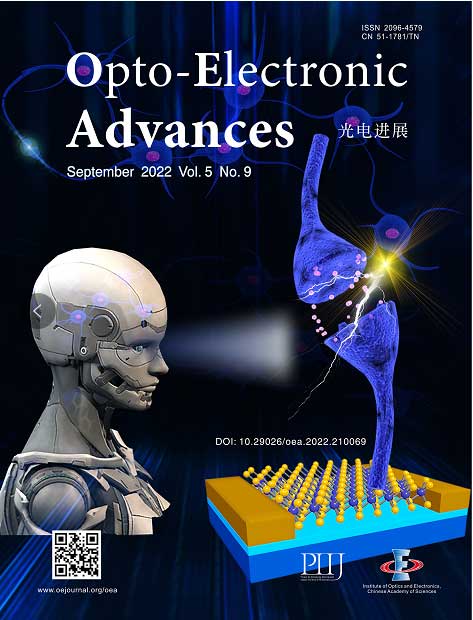2022 Vol. 5, No. 9
Cvoer story: Li CH, Du W, Huang YX, Zou JH, Luo LZ et al. Photonic synapses with ultralow energy consumption for artificial visual perception and brain storage. Opto-Electron Adv 5, 210069 (2022).
Neuromorphic photonic and electronic devices can meet the requirements of artificial intelligence (AI) for low power consumption and high efficiency, which is expected to break the von Neumann bottleneck. Biomimetic devices based on 2D materials have been extensively studied in photonics and optoelectronics due to their excellent photodetection capability and inherent persistent photoconductivity (PPC) effect. Recently, the research group of Optical Detection and Sensing (GODS) at University of Electronic Science and Technology of China (UESTC), led by Professor Jiang Wu, has reported a three-terminal photonic synaptic transistor with ultrafast speed within 5 μs and ultralow power consumption about 40 aJ, demonstrating the possibility of energy-efficient neuromorphic applications. Synaptic functionalities including short synaptic plasticity (STP), long synaptic plasticity (LTP), paired-pulse facilitation (PPF) and the classical Pavlovian conditioning can be successfully simulated based on the reported device. The sensitive gate-controled photoresponse displays the effect of different emotions on the function of human memory. This work has elaborated the working mechanism of the carrier trapping/detrapping, i.e. regulating the conductivity of the channel by optical stuimuli and the gate voltage. The reported synaptic device integrating sensing memory-preprocessing capabilities shows great potential in the field of artificial visual perception and brain storage.

-
{{article.year}}, {{article.volume}}({{article.issue}}): {{article.fpage | processPage:article.lpage:6}}. doi: {{article.doi}}{{article.articleStateNameEn}}, Published online {{article.preferredDate | date:'dd MMMM yyyy'}}, doi: {{article.doi}}{{article.articleStateNameEn}}, Accepted Date {{article.acceptedDate | date:'dd MMMM yyyy'}}CSTR: {{article.cstr}}
-
{{article.year}}, {{article.volume}}({{article.issue}}): {{article.fpage | processPage:article.lpage:6}}. doi: {{article.doi}}{{article.articleStateNameEn}}, Published online {{article.preferredDate | date:'dd MMMM yyyy'}}, doi: {{article.doi}}{{article.articleStateNameEn}}, Accepted Date {{article.acceptedDate | date:'dd MMMM yyyy'}}CSTR: {{article.cstr}}

 E-mail Alert
E-mail Alert RSS
RSS


